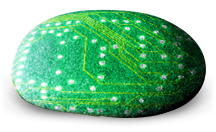 Mobile computing's rise from niche market to the mainstream is among the most significant technological trends in our lifetimes. And to a large extent, it's been driven by the bounty of Moore’s Law—the rule that transistor density doubles every 24 months. Initially, most mobile devices relied on highly specialized hardware to meet stringent power and size budgets. But with so many transistors available, devices inevitably grew general-purpose capabilities. Most likely, that wasn't even the real motivation. The initial desire was probably to reduce costs by creating a more flexible software ecosystem with better re-use and faster time to market. As such, the first smartphones were very much a novelty, and it took many years before the world realized the potential of such devices. Apple played a major role by creating innovative smartphones that consumers craved and quickly adopted.
Mobile computing's rise from niche market to the mainstream is among the most significant technological trends in our lifetimes. And to a large extent, it's been driven by the bounty of Moore’s Law—the rule that transistor density doubles every 24 months. Initially, most mobile devices relied on highly specialized hardware to meet stringent power and size budgets. But with so many transistors available, devices inevitably grew general-purpose capabilities. Most likely, that wasn't even the real motivation. The initial desire was probably to reduce costs by creating a more flexible software ecosystem with better re-use and faster time to market. As such, the first smartphones were very much a novelty, and it took many years before the world realized the potential of such devices. Apple played a major role by creating innovative smartphones that consumers craved and quickly adopted.
To some extent, this is where we still stand today. Smartphones are still (relatively) expensive and primarily interesting to the developed world. But over the next 10 years, this too will change. As Moore’s Law rolls on, the cost of a low-end smartphone will decline. At some point, the incremental cost will be quite minimal and many feature phones of today will be supplanted by smartphones. A $650 unsubsidized phone is well beyond the reach of most of the world compared to a $20 feature phone, but a $30 to $40 smartphone would naturally be very popular.
In this grand progression, 2013 will certainly be a significant milestone for mobile devices, smartphones and beyond. It's likely to be the first year in which tablets out-ship notebooks in the US. And in the coming years, this will lead to a confluence of high-end tablets and ultra-mobile notebooks as the world figures out how these devices co-exist, blend, hybridize, and/or merge.
Against this backdrop, in this two-part series, we'll explore the major trends and evolution for mobile SoCs. More importantly, we'll look to where the major vendors are likely going in the next several years.
Tablet and phone divergence
While phones and tablets are mobile devices that often share a great deal of software, it's becoming increasingly clear the two are very different products. These two markets have started to diverge and will continue doing so over time.
From a technical perspective, smartphones are far more compact and power constrained. Smartphone SoCs are limited to around 1W, both by batteries and by thermal dissipation. The raison d’etre of a smartphone is connectivity, so a cellular modem is an absolute necessity. For the cost sensitive-models that make up the vast majority of the market, the modem is integrated into the SoC itself. High-end designs favor discrete modems with a greater power budget instead. The main smartphone OSes today are iOS and Android, though Windows is beginning to make an appearance (perhaps with Linux or BlackBerry on the horizon). Just as importantly, phone vendors like HTC must pass government certification and win the approval of carriers. There is very much a walled-garden aspect, where carriers control which devices can be attached to their networks, and in some cases devices can only be sold through a certain carrier. The business model places consumers quite far removed from the actual hardware.
In contrast, tablets are far more akin to the PC both technically and economically. The power budget for tablet SoCs is much greater, up to 4W for a passively cooled device and as high as 7-8W for systems with fans. This alone means there is a much wider range of tablet designs than smartphones. Moreover, the default connectivity for tablets is Wi-Fi rather than a cellular modem. The vast majority of tablets do not have cellular modems, and even fewer customers actually purchase a wireless data plan. As a result, cellular modems are almost always optional discrete components of the platform. The software ecosystem is relatively similar, with Microsoft, Apple, and Google OSes available. Because tablets eschew cellular modems, the time to market is faster, and they are much more commonly sold directly to consumers rather than through carriers. In terms of usage models, tablets are much more PC-like, with reasonable-sized screens that make games and media more attractive.
Looking forward, these distinctions will likely become more pronounced. Many tablets today use high-end smartphone SoCs, but the difference in power targets and expected performance is quite large. As the markets grow in volume, SoCs will inevitably bifurcate to focus on one market or the other. Even today, Apple is doing so, with the A6 for phones and the larger A6X for tablets. Other vendors may need to wait a few years to have the requisite volume, but eventually the two markets will be clearly separate.
Horizontal business model evolution
Another aspect of the mobile device market that is currently in flux and likely to change in the coming years is the business model for the chip and system vendors. Currently, Apple is the only company truly pursuing a vertically integrated model, where all phones and tablets are based on Apple’s own SoC designs and iOS. The tight integration between hardware and software has been a huge boon for Apple, and it has yielded superb products.

The rest of the major SoC vendors (e.g., Intel, Qualcomm, Nvidia, TI, Mediatek, etc.) have stayed pretty far away from actual mobile devices. These companies tend to focus on horizontal business models that avoid competing with customers or suppliers.
In the long term, mobile devices are likely to evolve similarly to the PC and favor a horizontal business model. The real advantage is one of flexibility; as costs drop and the market expands, it will be increasingly necessary for vendors like HTC to offer a wide range of phones based on radically different SoCs. While a vertically integrated company like Apple can focus and maintain leadership in a specific (and highly lucrative) niche, it would be very difficult to expand in many growing areas of the market. The differences between an iPhone 6 and a $20 feature phone are tremendous and would be very difficult for a single company to bridge.
However, SoC vendors will attempt to reap the benefits of vertical integration by providing complete reference platforms to OEMs. Conceptually, this is a form of "optional" system integration, where the phone vendor or carrier can get the entire platform from the SoC supplier. This has the principal advantages of reducing time to market while also providing a baseline quality and experience for consumers. Currently, this approach has mostly been tested in emerging markets, but it's likely to become more common over time. There is a crucial distinction between reference platforms and vertical integration. Namely, OEMs can always choose to customize a platform to differentiate, and the SoC vendor avoids dealing with consumers directly. Typically, most of the customization is in terms of software on top of a base operating system.

Focus on the intellectual
One unique aspect of mobile devices is the availability and prevalence of third-party intellectual property (IP). Unlike the PC industry, it is a common practice for SoC vendors to use a variety of external and internal IP. ARM and Imagination Technologies are the best known IP vendors, with reputations established for CPUs and GPUs respectively. Most major SoC blocks are available as IP, which creates a very broad and diverse ecosystem. Even vertically integrated companies such as Apple rely on third-party IP.
Vertical integration of IP within the context of a single chip makes tremendous sense and is likely to be the future for most SoC vendors. While third-party IP is highly flexible and can reduce time to market and development costs, it comes with real trade-offs. The licensing costs are typically on a per-unit basis and thus are increasingly problematic at high volume. At a certain point, the variable licensing costs outweigh the fixed development costs, and it makes more sense to use internal resources.
Moreover, there are risks associated with third-party IP that are more difficult to control. For instance, Intel’s Clovertrail tablet has been delayed, likely due to problems with the Imagination Technologies graphics drivers for Windows 8. And third-party IP is often intended to address a wider market and may not fit with the intentions of a specific vendor. For instance, licensed ARM cores cannot be substantially modified, which removes an element of flexibility for companies with good CPU design teams.
Over the next decade, the higher volume vendors will likely focus on reducing the amount of external IP and emphasizing internal development expertise. That means licensing ARM’s instruction set and designing custom cores (as Apple has done with the A6), rather than using the stock cores. In other cases, SoC vendors will develop or acquire the necessary building blocks, such as baseband processors. One area where third-party IP will probably continue to be popular is graphics, largely because of the complexity of the software stack. Modern graphics APIs and drivers are very challenging, and the development cost may prove prohibitive for all but the very largest companies.
Manufacturing trends
The SoCs for mobile devices are inextricably tied to semiconductor manufacturing, and any look into the future must be based on a realistic assessment of the underlying technology. While Moore’s Law has continued to operate, certain aspects of silicon scaling stopped roughly a decade ago. In particular, shrinking transistors ceased granting an intrinsic increase in performance. The industry adapted and embraced a number of novel technologies to boost performance where appropriate.
Perhaps the biggest question looming over the industry is the fate of Moore’s Law and whether transistors will continue to shrink. Ten years is a very long time to make technical projections with any degree of certainty. However, there is no reason to believe that process technology scaling will stop—the advantages of shrinking are still quite large. In the next few years, the industry will move from 193nm conventional lithography to 13nm EUV lithography, which should last for quite some time. Going forward, though, innovations in materials will be absolutely necessary for Moore’s Law, and these will happen at a faster pace. To date, the major changes in manufacturing have been copper interconnects, strained silicon, high-k/metal gates, and now fully depleted transistors (e.g. FinFETs or FD-SOI), and there is plenty of promising research for the roadmap.
However, these new techniques are increasingly expensive from both a development and variable cost standpoint. Each new technique tends to winnow the field of manufacturers a bit more. Fujitsu and TI both have excellent process technology, but they could not afford to develop high-k/metal gates at the 32nm node and instead moved to a fabless model for digital logic. It's nearly certain that the number of leading edge manufacturers will shrink to just a handful. Intel, TSMC, and Samsung have the volume and can continue to afford the pace of Moore’s Law, but the economics may be prohibitive for everyone else.
Even so, a fabless model is not necessarily a panacea because of the rising variable costs. In the past, TSMC and many foundries have been able to avoid expensive techniques, but that option is no longer feasible. For instance, conventional lithography cannot draw features below 80nm without multiple patterning. If double patterning is required for a process step, it will cut the throughput of that step in half. FinFETs are similarly complex and will impact throughput as well. These costs (along with profits for TSMC or GlobalFoundries) are ultimately passed along to foundry customers as higher wafer prices.
Long-term, this translates into an advantage for the two IDMs: Intel and Samsung. First, an IDM essentially pockets the profits from both manufacturing and design, whereas fabless companies only collect the latter and must give up the former to TSMC or GlobalFoundries. Second, IDMs have greater control over the supply chain and are less likely to be subject to availability problems as a result of manufacturing challenges. Third, the cost delta between IDMs and foundries is likely to erode for the technical reasons outlined above.
One new technique which will be adopted across the industry over the next decade is 3D integration. Many mobile devices already use chip stacking, where several different integrated circuits are vertically stacked in a single package. Typically, chip stacking relies on connecting different layers of the stack with low-density bond wires or solder bumps. However, many companies are actively working on solutions to connect different layers via through-silicon vias (TSVs), which are much denser and offer greater connectivity and power savings. 3D integration using TSVs is far more sophisticated than 3D packaging, since a single integrated circuit can span multiple layers. The primary use case for 3D integration is packaging high-speed memory with an SoC to deliver superior bandwidth for graphics. Currently, the only products using 3D integration are FPGAs from Xilinx, but the technology should become relatively common during the next few years, and it should be available later to all mobile vendors.
Manufacturing roadmap
Currently, Intel is about two years ahead of the rest of the industry in terms of high-volume manufacturing for high-performance products (i.e. server, desktop, and notebook SoCs). Intel’s 22nm Ivy Bridge went into production at the end of 2011, around the same time that TSMC started producing 28nm GPUs. Additionally, Intel tends to be about one node ahead of the industry for performance features such as strained silicon, high-k/metal gates, and FinFETs (e.g. Intel introduced high-k/metal gates in 2007, foundries in 2011 and 2012). Looking forward, Intel’s manufacturing is expected to stay on a two-year cadence at least through the 10nm node in late 2015, and there is no reason to expect any deviation from this trend further out.
However, Intel’s mobile SoC designs are two years behind the cutting edge of manufacturing, with 32nm SoCs shipping today. Over the next two to three years, Intel will pick up the pace of SoC development, hitting 22nm by the end of 2013 and 14nm by the end of 2014. Long-term, the mobile SoCs will probably reach about six months behind the PC designs in terms of manufacturing, driven by cost constraints. Specifically, Intel’s fabs are quite expensive for the first year, when yields are still ramping up and the factory is depreciating. The ASPs for notebooks and desktops are high enough to amortize these costs. After six to 12 months, the costs are much lower and more amenable to phone and tablet products.
Looking at the foundries is a little more challenging and confusing. First of all, TSMC, GlobalFoundries, and Samsung tend to announce production well in advance of actual mobile SoCs shipping. However, assuming a two-year cadence is a very reasonable guideline. That places the 20nm planar node (and attendant SoCs) in late 2013 or early 2014.
The 14nm node will be quite problematic for the foundries, though. Without EUV, it will be necessary to use double patterning on the metal interconnects, which will substantially increase costs. Instead, the foundries are developing a hybrid process that uses a 14nm FinFET to boost performance, but they're keeping the same 20nm metal interconnect. From a practical standpoint, this means the foundry 14nm process will be comparable to Intel’s 22nm process in terms of performance and density, despite the name. The foundries claim that the hybrid 14nm/20nm process will arrive in 2015, which seems somewhat optimistic given the challenges involved in achieving yield for FinFETs. Moreover, that will make the transition to a 10nm node even more difficult, as the foundries will have to move from 20nm interconnects to 10nm interconnects and skip a generation.
Long-term, it seems like the foundries are expending significant effort to narrow the gap with Intel. Historically, this has proven to be an elusive goal, and there are few fundamental changes that suggest this would be feasible. It's most likely Intel’s mobile SoCs will accelerate over the next few years and ultimately reach and then maintain a 12 to 18 month lead in process technology (and hence density) over the competition. The real question is how fast the foundries will be able to implement techniques like FinFETs and other performance enhancements. It is quite possible this gap could narrow from the current four to five years down to three to four years.
In the conclusion of this series, we will explore how these trends come together and impact the leading mobile SoC vendors and where they are expected to evolve over the next five to ten years.
David Kanter is Principal Analyst and Editor-in-Chief at Real World Tech, which focuses on microprocessors, servers, graphics, computers, and semiconductors. He is also a consultant specializing in intellectual property evaluation/development and technical/competitive analysi
Put yourself in your visitors shoes - think about what they might use to discover you in
ReplyDeletethe search engines. It is valid, therefore, that it must be possible to obtain a
high listing without much content, but having a large quantity of links.
Take part in forums, write articles, blogs (including 'blogger' that Google owns), maybe even purchase a
link back in your web site.
My web page review of magic article rewriter